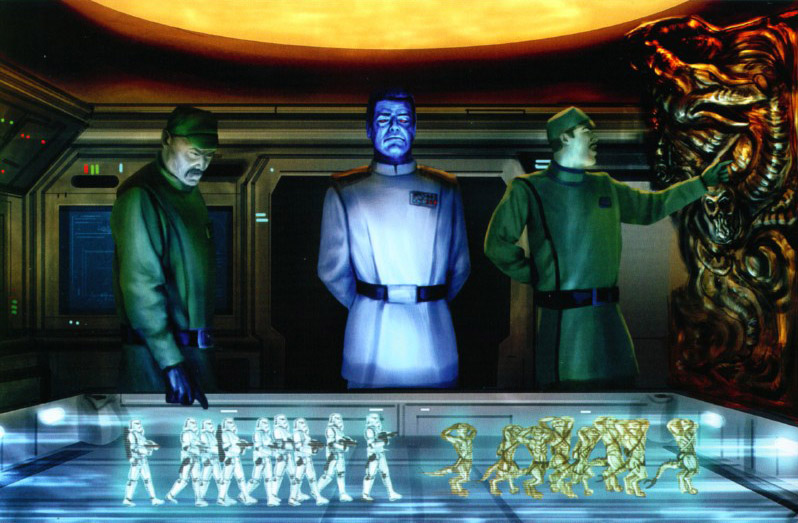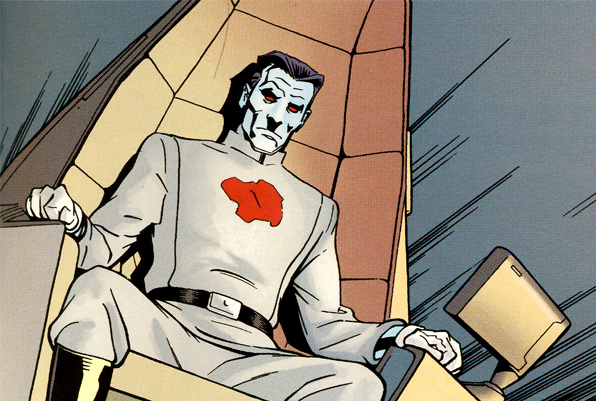

Grand Admiral Thrawn, of Timothy Zahn’s Heir to the Empire trilogy, was one of the most brilliant opponents ever faced by the New Republic. He outmaneuvered the heroes deftly, often defying impossible odds to accomplish stunning victories over the heroes. At the time of his death, Grand Admiral Thrawn had the New Republic on its knees. In a letter to a fan, Zahn described the blue menace as a composite of several figures: the fictional detective Sherlock Holmes, as well as several historical military figures: Hannibal Barca, Robert E. Lee, and Erwin Rommel, among others. Thrawn’s deductive abilities are almost certainly drawn from Conan Doyle’s famous detective, Sherlock Holmes. Holmes is able to assemble an accurate picture of how a crime occurred through deductive abilities, impeccable observation skills, and the aid of his trusty compatriot Dr. James Watson, who serves as the narrator in the Holmes stories. One of Thrawn’s signature traits is his ability to deduce his opponents’ actions before they even begin said actions, through a thorough understanding of psychology, an encyclopedic knowledge of military tactics, and the understanding of alien mindsets through the study of alien art. He even has his own Watson, in the form of Captain Gilad Pellaeon, captain of the Star Destroyer Chimaera and later Grand Admiral of the Imperial Remnant.
“Aut Inveniam Viam Aut Faciam”

Thrawn’s campaigns against the New Republic greatly resemble the context and actions concerning Hannibal Barca’s campaign against the Roman Republic during the Second Punic War. For those who are unfamiliar with him, Hannibal Barca was a Carthaginian general who was the key figure on the Carthaginian side of the Second Punic War, and one of the most brilliant minds in military history (“Punic” being the general Latin term for the Carthaginians, due to their Phoenician ancestry). He in fact instigated the Second Punic War by attacking Roman allies in modern-day Spain, and then accomplished the seemingly impossible feat of marching a diverse army of Carthaginian troops, allies, and mercenaries over the Alps- famously taking elephants with him in the process. Hannibal dealt several crushing defeats to the Romans, particularly at Lake Trasimene in 217 and Cannae in 216- where he slew half of the Senate, both consuls, and upwards of 60,000 Roman and allied troops. Hannibal even managed to briefly encircle the city of Roma herself, in an attempt to draw off Roman pressure on the city of Capua. Although he eventually lost the Second Punic War- being defeated by Publius Cornelius Scipio Africanus after having gradually lost a war of attrition in Italy and being driven back to North Africa- Hannibal remained one of the most feared men in the Roman consciousness, to the point that he was incessantly hounded by Roman forces after he went into exile in the Seleucid Empire.

The scope, shape, and sheer ingenuity of Thrawn’s tactics and campaign draw on Hannibal. Like the Carthaginian conqueror, he was forced to work with limited financial and military resources- many Imperial Fleet elements were held back from Thrawn by warlords, and his initial maneuvers were accomplished with a handful of Imperial- and Victory-class Star Destroyers. Thrawn’s ability to hit the New Republic where they least expected it mirrored Hannibal Hannibal was in danger of being disavowed by the Carthaginian Assembly after instigating the war, and had to assemble his force as he marched through Iberia, Gallia Transalpina, and finally Northern Italy. With these limited forces, he was able to inflict some of the most devastating defeats ever suffered in military history. Like Hannibal, Thrawn’s campaigns brought him to the very gates of his enemy’s capital- a capital once held by the Roman-inspired Galactic Republic, which the New Republic saw itself as a revival of. Eventually, of course, Thrawn was defeated- although unlike Hannibal, Thrawn died by the hand of an assassin, rather than his own. Indeed, the Battle of Bilbringi at the climax of The Last Command conceptually resembles what might have occurred had Hannibal been more successful, and driven the Romans back to the plain of Latium. Thrawn and Hannibal’s legacies lived on after their defeats- Hannibal’s mere presence in the Seleucid Empire caused a diplomatic scuffle with the Romans, whereas the mere rumor of Thrawn’s return from death caused numerous systems to defect back to the Imperial Remnant.
The “Honorable Opponent”

In recent years, Thrawn has undergone a bit of a facelift. Hand of Thrawn, Survivor’s Quest, Outbound Flight, and Choices of One have all done a great deal to alter the image of Thrawn as a simply more brilliant, cultured Imperial warlord. He has been reinterpreted as one of the “good Imperials”- a principled man who fought for the Galactic Empire. He has been reinterpreted as having the best interests of the galaxy at heart, attempting to prepare the GFFA for the Yuuzhan Vong invasion, and also being portrayed as contemptuous of Darth Vader’s often brutal style of leadership. Even in-universe, his former opponents feared and respected him and his legacy. This new version of Thrawn resembles the regard with which Robert E. Lee and Erwin Rommel are held today. Robert E. Lee is widely perceived as an honorable man fighting for a dishonorable cause- fighting on behalf of the South due to his loyalty to the state of Virginia, rather than out of particular support for slavery. Similarly, Thrawn seems to have fought (in his mind, at least) on behalf of the galaxy, and simply saw the Galactic Empire as the best means of opposing the Vong. Both are highly regarded generals- Lee at times came close to winning the American Civil War in favor of the Confederate States of America, while Thrawn came within a few cannonades of completely reversing the tide of the Galactic Civil War.
Similarly, Erwin Rommel has often been viewed (rightly or wrongly) as a good man fighting for a bad system. Like Thrawn, Rommel served as a general for a fascist power bent on domination of the known world. He was also able to outmaneuver skilled opponents such as Bernard Montgomery, similar to Thrawn’s defeats of numerous New Republic generals and admirals. Rommel is often perceived as having a distaste for Nazi policies, and in particular Hitler’s style of leadership. Thrawn expressed a similar disgust with Darth Vader’s often brutal style of leadership, seeing it as a waste of good military resources. The Desert Fox was even implicated in the 20 July Plot against Adolf Hitler (which was loosely adapted by Star Wars: Empire issues 1-4). For his supposed participation in the assassination attempt, Rommel was ordered to commit suicide by der Fuhrer. While Thrawn was assassinated by his bodyguard, there is a passage in the Dark Empire Sourcebook which suggests that the Reborn Emperor had a hand in steering Rukh the Noghri towards stabbing the Grand Admiral.

